In just over a month the chicks have gone through a stunning transformation. That adorable puff-ball stage lasts only three days. Then the quills emerge, first on the wings, then on the necks. Soon more down flies and more feathers come in. Plumage seems to change as fast as the “horse of a different color” went from pink to blue in the Wizard of Oz The chicks’ mature look won’t occur until they are laying eggs, at about five months of age. Until then, I’ve been watching the costume changes and trying to match the chick to the breed.
My Meyer Hatchery order of 25 chicks specified ten different breeds. When the chicks arrived some were yellow, some were stripey like chipmunks, two had feathers on their feet and two were dead. The hatchery web site has photos of chicks, but honestly, all those yellow chicks look alike. Ken and I divided the order as best we could.
This is what was ordered: 2 Delawares, 2 Blue Cochins, 2 Barnevelders, 2 Welsummers, 2 Buff Chantecleers, 2 NH Reds, 2 Buff Orpingtons, 3 Dominques, 3 RI Reds, and 5 Speckled Sussex.
I know that I got the Blue Cochins that I wanted. Size and temperament vary as much as their sizes, but their color and the feathered feet confirm their breed.
Also obvious are the Speckled Sussex. They’re clearly dotted (I’m told the white swath on their chest will disappear as they mature.) It appears that I have three, so Ken is missing one, but that’s okay with both of us. There’s a lot of variation between the three in size and coloration. It’ll be interesting to see what they look like next year.
But, maybe I don’t have three. That one on the left has beige legs, not yellow. Is she something else?
At least the Delaware is obvious. Should I be worried about the size of “her” comb? It’s large, but pale. I know it’s a Delaware, but I’m not 100% convinced that it’s a girl.
Then there are the three yellow chicks. Ken has what we think are the two Buff Chantecleers. I’m supposed to have the Buff Orpingtons. Only two. But there are three. Two have the white legs and skin of the Orpington, but the other is a tad darker. (See the one on the left?) The problem is, there’s not another chicken on the order that should be yellow. However, we did get an extra chick (the hatcheries usually send a spare.) So, this must be it. The question is, what is it?
And then there are the brown chicks. There are two of these. I think they’re my New Hampshire Reds.
But I could be wrong. There’s also this one. Is it the Rhode Island Red? Or a Welsummer?
And there’s this gorgeous dark chick. Maybe she’s a Barnevelder. Do I even have a Welsummer?
What do you think?
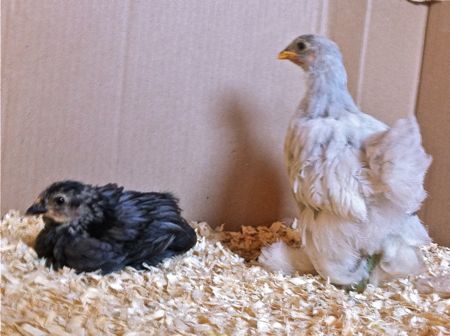
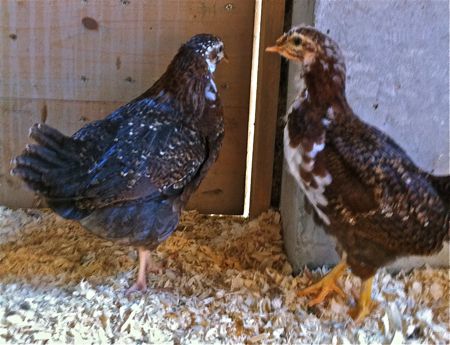
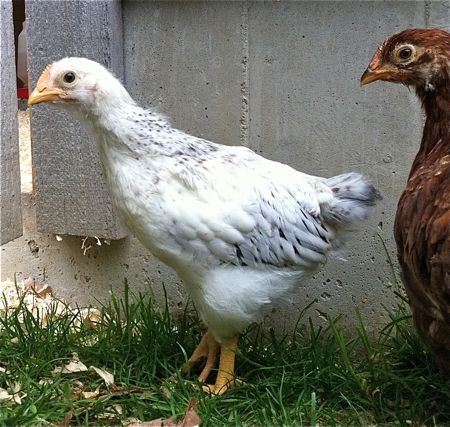
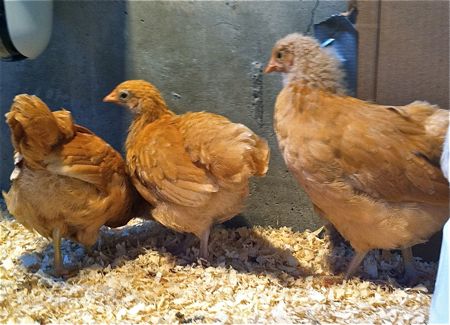

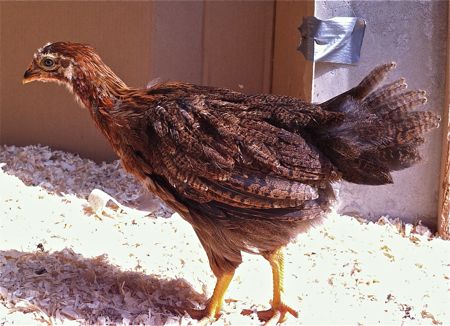
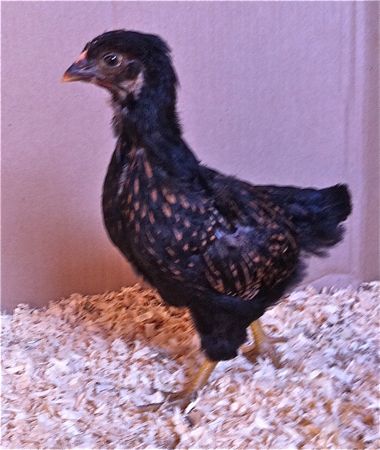

Oh, they’re all so darn cute. Have you decided on names yet?
Waiting to see more mature feathering. Have ideas, though!
That last one is almost certainly the Barnevelder. I have the other one – you’re gonna love her. They’re full of personality (not to mention one of the prettiest chickens around)
I have no idea!!!
The paler of the Cochins we would call Splash rather than Blue. She’ll be lovely.
And I love that little dark one with gold lace markings – she’s going to be a stunner!
Celia
I have 3 Speckled Sussex and they all have beige/pinky legs not yellow. And in past years I’ve had a few hens that had large combs…one even larger than the rooster I had..I thought maybe it was a hormone thingy but she never had a problem with laying eggs.
Ha Ha Ha!! How fun for you, trying to figure them all out:-)) I have 2 Welsummers and yours looks like one. Other than that, I’ve no clue. But I’m looking forward to future postings as they mature.
I bought what I thought were four Ameracauna chicks. One is a gorgeous orange gold(thinking rooster), one is definately an Ameracauna, and two are beautiful snow white with black markings question marks!!! And one of my four Australorps turned out to be a Barred Rock! Ah well.
the dark with gold lace is going to be a stunner. really like the reds in the rhode islands. i like the name ‘welsummers’.
I am not well versed on the breeds, but they are all so darn cute. Tell little Saphire, Diamond, Topaz, Emerald, Opal, Pearl, and Ruby I said Hello.
Terry I think you’ve identified them correctly. The unknown one maybe a buff rock or possible a buff minorca. Although it looks more like a heavy breed. The orps seem to have more rounded tail feathers and the rocks for pointy. From the camera angle it looks like the unknown has more pointy tail feathers. That’s my guess.
I’m with you on that deleware, I’m not convinced it’s pullet, the more I look at the photo those waddles look a little pronounced for a pullet. The only hesitation I have, like you, is the paleness.
I’ll take a closer look at mine tonight and report back. ;-)
Do you see any indication of saddle feathers on the deleware?
Hi Terry..Hate to keep going back to the sick bird syndrome..but I ended up putting all my birds on Tylan…I had too many sneezing and acting punky to do injections on all of them…My question is how long on the Tylan and please clarify the withdrawal period. The internet posts say none and then others say 7 days AFTER the last dose…does that mean you can eat them up until you adminster the last dose? I am very confused. I don’t want to sell eggs to anyone if it is unsafe. Thanks for you expertise as always!
My vet tell me that the hens stay on the water-soluble Tylan for 10 (that’s if the symptoms clear. Longer if necessary.) Eggs are edible to humans 12 days after the medicated water is removed. The Doxcycline has a 30 day withdrawal period.
Ok…really stupid question, but I’ve been wondering about this for awhile.
I know that you want productive hens. But if this Delaware turned out to be a male, and you really liked him, could you get him nutered? And if he was, would that snuff out some of the rooster tendancies?
I know it’s impractical and expensive, but I was wondering if it’s possible.
You have a wonderful assortment there. I’ve really enjoyed watching them grow up. Thanks for sharing them.
Not stupid, especially for people coming from having only had pets. “Capons” are neutered boy chickens. They’re “caponized” for the sole purpose of having he chickens put on weight. In the days when farmers hatched their own replacement stock, 1/2 would be roos, and it made economical sense to keep them for meat and get them as fat as possible (usually to be sold at a premium during a holiday season.) The procedure is done’ by the farmer (a quick snip for the experienced) and is not done after 3 weeks as it gets much more difficult. I’ve never heard of anyone doing it to an older bird to keep as a pet. My reading states that the capons have healthy issues due to their fast growth (but that’s true with all meat birds.) The capons do stop crowing, though!
I’m confused. If you don’t know if you have a male or female at 5-6 weeks, how do you know that you have a male at less than 3 weeks if you want to “caponize”?
There’s a trick to sexing chicks – that’s why the hatcheries can sell the girls for a premium. It’s a skill most of us don’t have!
My old farming books (from the mid-to-late 1800’s) contain directions for castrating roosters and somewhere, don’t ask me where, I have a little kit to do the operation. It’s still done commercially–we call them capons and pay a big price for them!
Last one might be a Golden Laced Wyandotte…looks just my new girl I go in February! Gorgeous bird.
I agree..looks like a Wyandotte..I have one..she is gorgeous…Delawares can be rather large…few more weeks and we will know for sure….roo or hen?
Heard about your tornado warning and saw that all the animals were locked up. Be safe and we’re thinking of you. Thankfully and knock on wood; Seattle doesn’t have any of this type of weather.
Tornados passed 60 miles west of here. We had only a few large branches down and none of the hailstorms. Still, the sky was a scary yellow!
Thank goodness it missed you, yep you nailed the color. The yellow and green color is the sun behind the wall cloud.
I think the second to last chick is a wellsummer and the bottom chick is a dark cornish…i think…
I just got back from the post office with my mail order chicks, now, we have 11 of the big chickens outside, my dad is building me a coop for the bigger indoor chicks, and today, I got 1 white crested black polish, 1 brown leghorn, 1 dark cornish, and 1 buff bearded polish!
One of the first three chicks I got was a Delaware. She turned out to be a he……. Yours looks similar to him…notice the haunch feathers starting to turn down. Does he have nubs on the back of his legs yet?
I want more chicks this summer!
Good luck, and thanks for all the insight, but so sorry about Lulu.
the 3rd chick from the bottom that you said you think is a New Hampshire Red- looks very much like my 2 that I was told are Rhode Island Reds. I am wondering if my info is wrong?
here is a link if you want to see mine for comparison-
http://i143.photobucket.com/albums/r121/zoabarker/610730195_photobucket_61883_-1.jpg
Second from the top is definitely your Welsumer, I have one too and it looks the same :) I’ll have to go check my Delaware and see how tall her comb is and get back to you. I didn’t get to spend any time with my girls yesterday :(
So, Terry, I’m going to try and put pics up on my blog for you. They aren’t the best cause they were made with my phone (the only camera I have) and because they were taken with the girls in the run ’cause the dog was oot and aboot, but hopefully you’ll get the idea :) Our girls are the same age. Gimme about five minutes ;)
Hi All- so many ideas! I think that the breeds I have are the ones ordered, so no Cornish or Wyandottes. The Delaware doesn’t have spur growths on the legs, so I’m being optimistic that it’s a girl. Keep your fingers crossed. RIRs (abbreviation for Rhode Island Reds) in my limited experience, are a more lustrous, darker mahogany than the NHRs. Unless side by side with the RIRs it’s hard to tell apart to the newbie. Another two weeks and all will be known!
Hi terry i have two new chicks and i dont know what kind they are I have one yellow with a comb and one black and white is the yellow one a rooster?
Those sound about like every chick out there. You’ll know what they are in a few months :) Eventually the roosters will have large red combs and wattles, big tails, spurs and they crow. Until then, you’ll be guessing.
thanks any more info would be great!!!!!!..
do you have to worm chickens?and if soo what kind any info would be great!!!. (first time with chickens)
Am working on a blog about that. Short answer for you is that don’t have to do anything for your chicks.
i love watching your animals! i have some chickens and ducks and a goat
The last one, as Ken said, is definitely a Barnevelder. Such beautiful birds- gentle and quiet. When the sun shines on ours, it almost takes my breath away.
Love, love, love your blog.
That Barnevleder…. are you sure “she’s a girl”
mine is 4 months old and her comb hasn’t coloured up yet (not pink it’s practically cream coloured). I’m guessing that you’ve got a young fellow there.